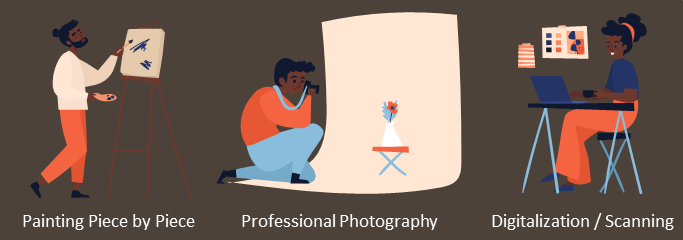Art Digitization: A Gateway to Preserving and Sharing Masterpieces
Art Digitization, the process of converting artwork into digital form, has revolutionized the way we preserve, share, and appreciate art. From galleries to artists, the adoption of digital reproduction techniques, especially using advanced tools like the WideTEK 36ART, has transformed the art world.
Exploring the World of Art Reproduction
Art reproduction is more than just creating a copy of original artwork. It’s about preserving and sharing cultural treasures. Whether it’s scanning, tracing, or repainting, these reproductions allow broader access to rare or expensive art, democratizing the experience of fine art.
Legal Aspects of Art Reproduction
When considering reproducing artwork, it’s vital to navigate the legal landscape. Copyright laws require anyone wishing to reproduce artwork to seek permission from the copyright holder. This process ensures respect for the original artist’s rights and contributions.
The Legality of Selling Reproduction Art
For artists and galleries, selling art reproductions is not just a legal practice but also a way to extend the reach of art. Provided the artwork is in the public domain, selling its reproductions, clearly marked as such, is perfectly acceptable and widely practiced.
The Significance of Art Reproduction
Reproducing art serves multiple purposes. It’s not just about creating a copy; it’s about sharing an artist’s vision with a broader audience, adding value to the original pieces, and preserving these masterpieces for future generations to admire and study.
Why Art Reproduction?
Duplicating an artwork allows the owner to share the artist creativity with a broader audience, increase the value of your originals, and preserve your masterpieces for generations to come.

Various Techniques can be used to Duplicate Artwork
Diverse Techniques in Artwork Duplication
Duplication of artwork can be achieved through several methods, each with its unique pros and cons.
Painting and Tracing Techniques
One traditional method involves painting piece by piece or tracing. This hands-on approach ensures a high degree of authenticity in the reproduction.
Pros: Creates high-value duplicates. Cons: Time-consuming and produces limited copies.
Professional Photography in Art Reproduction
Using professional photography is another method. It involves capturing the artwork in a controlled environment to create high-resolution digital reproductions.
Pros: Allows the creation of numerous prints. Cons: Demands extensive setup and specialized equipment.
The Role of Digitalization and Scanning
Digitalization, particularly scanning, offers a modern approach. It involves using scanners like the WideTEK 36ART for a direct, high-quality digital copy of the artwork.
Pros: Quick, efficient, and safe for the artwork. Cons: Requires investment in high-quality scanning equipment.

A museum Gallery showcasing Art Digitization
Introducing WideTEK 36ART for Art Digitization
ABTec’s WideTEK 36ART scanner revolutionizes the process of art digitization. Designed specifically for fine art, it’s a game-changer in the field.
WideTEK 36ART: A Technological Marvel
The WideTEK 36ART is not just a scanner; it’s a portal to preserving and sharing art. Its cutting-edge technology allows for high-resolution scanning of various art forms up to 36 x 60 inches, with an optional extension for even larger works.
The Contact-Free Scanning Process
One of the standout features of the WideTEK 36ART is its contact-free scanning capability. This ensures that delicate artworks are not damaged during the digitization process.
Integration with Printing Technology
Moreover, WideTEK 36ART’s compatibility with large format printers from leading brands ensures that the digital reproductions are as close to the original as possible, both in color and texture.

WideTEK 36ART: Revolutionizing Art Digitization
Mastering the Art of Scanning with WideTEK 36ART
Using WideTEK 36ART, galleries, museums, and reprography specialists can digitize art for various purposes, from sales to cataloging and online display. The scanner’s technology ensures that each reproduction is a faithful representation of the original.
Preserving Art for the Future
The WideTEK 36ART’s advanced technology plays a crucial role in art preservation. By creating high-quality digital versions, the physical artwork’s longevity is enhanced, safeguarding it for future generations.
The Business Potential of Art Digitization
Art digitization is not just about preservation; it’s also a lucrative market. Galleries and museums can use the WideTEK 36ART to digitize their collections for sale as prints or for use in publications, while reprography specialists can offer art digitization as a premium service.
Conclusion: Embracing the Future of Art
The journey of art reproduction with the WideTEK 36ART is an exciting one. It allows artists, galleries, and museums to share and preserve the beauty of art in a way that was never possible before. The WideTEK 36ART ensures that every reproduction is a testament to the original’s spirit and beauty.
Contact ABTec Solutions today on Toll Free (800) 775.8993 or reach out and fill the form and we will contact you as soon as possible.




